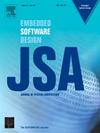一种用于下一代无线网络智能农业安全大数据分析的认证密钥协议方法
IF 4.1
2区 计算机科学
Q1 COMPUTER SCIENCE, HARDWARE & ARCHITECTURE
引用次数: 0
摘要
预计下一代无线网络将是极其复杂和动态的。自动驾驶汽车、智能农业、智能医疗系统等应用都是它们的可能用途。智能农业是一种农业管理形式,它利用现代信息和通信技术(ict)来提高所生产产品的数量和质量。下一代无线网络促进智能农业。智能农业的主要目标是为农业行业提供所需的基础设施,以利用机器学习、大数据、云计算和物联网(IoT)等尖端技术跟踪、监控、自动化和分析流程。这些是智能农业中使用的一些技术。智能农业采用技术来创造各种预测。通过一个描述性的仪表板,例如一个移动应用程序或Web应用程序,农民可以密切关注他们的作物,并根据他们的发现做出选择。然而,由于设备和服务器通过不安全的媒介(即互联网)交换数据,这样的系统可能容易受到各种网络威胁和攻击。在本研究中,我们提出了一种用于下一代无线网络智能农业(简而言之,AKM-BDSF)安全大数据分析的认证密钥协议技术,以保护智能农业传输和存储的数据。详细的安全性分析和比较研究表明,所提出的AKM-BDSF在基本安全性和功能元素方面优于其他现有方案。此外,还对AKM-BDSF进行了实际验证,以观察其对性能的影响。本文章由计算机程序翻译,如有差异,请以英文原文为准。
An authenticated key agreement method for secure big data analytics in next-generation wireless networks-enabled smart farming
It is anticipated that next-generation wireless networks will be exceedingly complicated and dynamic. Applications like autonomous vehicles, smart farming, smart healthcare systems and more are all possible uses for them. Smart farming is a form of agricultural management that makes use of contemporary information and communication technologies (ICTs) in order to improve both the amount and quality of the products that are produced. Next-generation wireless networks facilitate smart farming. The primary goals of smart farming are to supply the agricultural industry with the infrastructure that is required to track, monitor, automate, and analyze processes utilizing cutting-edge techniques such as machine learning, big data, cloud computing, and the Internet of Things (IoT). These are some of the technologies that are being utilized in smart farming. Smart farming employs techniques to create varied forecasts. From a descriptive dashboard, such as a mobile app or Web app, the farmers can keep an eye on their crops and make selections based on their findings. However, such a system may be vulnerable to various cyber threats and attacks as the devices and servers exchange their data through an insecure medium (i.e., the Internet). In this study, we present an authenticated key agreement technique for secure big data analytics in next-generation wireless networks-enabled smart farming (in short, AKM-BDSF) to protect the transferred and stored data of smart farming. The detailed security analysis and comparative study reveal that the proposed AKM-BDSF outperforms other existing schemes in terms of essential security and functionality elements. Moreover, AKM-BDSF is demonstrated practically to see the effects on its performance.
求助全文
通过发布文献求助,成功后即可免费获取论文全文。
去求助
来源期刊

Journal of Systems Architecture
工程技术-计算机:硬件
CiteScore
8.70
自引率
15.60%
发文量
226
审稿时长
46 days
期刊介绍:
The Journal of Systems Architecture: Embedded Software Design (JSA) is a journal covering all design and architectural aspects related to embedded systems and software. It ranges from the microarchitecture level via the system software level up to the application-specific architecture level. Aspects such as real-time systems, operating systems, FPGA programming, programming languages, communications (limited to analysis and the software stack), mobile systems, parallel and distributed architectures as well as additional subjects in the computer and system architecture area will fall within the scope of this journal. Technology will not be a main focus, but its use and relevance to particular designs will be. Case studies are welcome but must contribute more than just a design for a particular piece of software.
Design automation of such systems including methodologies, techniques and tools for their design as well as novel designs of software components fall within the scope of this journal. Novel applications that use embedded systems are also central in this journal. While hardware is not a part of this journal hardware/software co-design methods that consider interplay between software and hardware components with and emphasis on software are also relevant here.
 求助内容:
求助内容: 应助结果提醒方式:
应助结果提醒方式:


